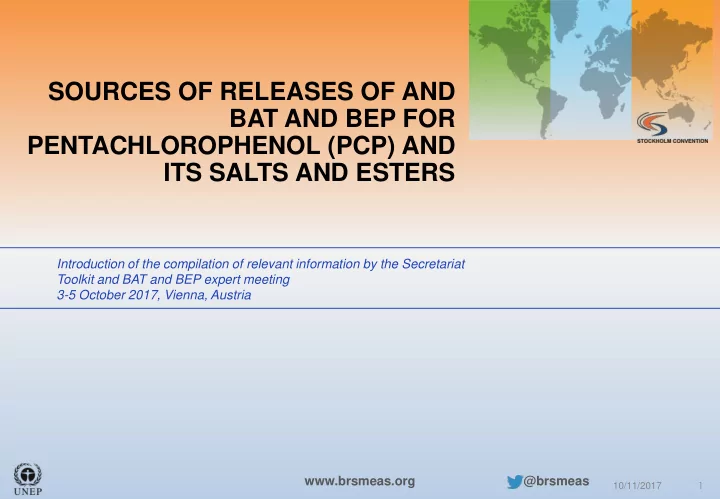

SOURCES OF RELEASES OF AND BAT AND BEP FOR PENTACHLOROPHENOL (PCP) AND ITS SALTS AND ESTERS Introduction of the compilation of relevant information by the Secretariat Toolkit and BAT and BEP expert meeting 3-5 October 2017, Vienna, Austria www.brsmeas.org @brsmeas 1 10/11/2017
LISTING OF PCP • Listed in Annex A with specific exemptions for production and use for utility poles and cross-arms • Each Party that has registered for the exemption is required to take necessary measures to ensure that utility poles and cross-arms containing PCP can be easily identified by labelling or other means throughout their life cycle • Articles treated with PCP should not be reused for purposes other than those covered by the exemption 2 10/11/2017 www.brsmeas.org @brsmeas
PRODUCTION AND USE • PCP has been produced commercially and used as a wood preservative since the 1930s • PCP can be produced by several methods: • Direct chlorination of phenols and hydrolysis of hexachlorobenzene (HCB) • Alkaline hydrolysis of HCB • Thermolysis of hexachlorocyclohexane (HCH), including a chlorination step and hydrolysis • PCP-Na was produced until 1984 using the alkaline hydrolysis of HCB. Now it is produced by dissolving PCP in sodium hydroxide solution • The major worldwide use of PCP has been as a heavy-duty wood preservative, used for utility poles and pilings, railway ties, outdoor construction materials and as a remedial treatment of timber and as a surface biocide • A number of other past uses are reported 3 10/11/2017 www.brsmeas.org @brsmeas
SOURCES OF RELEASES • PCP can be released to the environment during the course of its lifecycle: • Production facilities • Use of PCP in timber treatment • Preparation • Drying and conditioning • Wood treatment • Storage • Non-timber treatment uses of PCP • Leather treatment • Textile treatment • Agriculture • NaPCP production • Other application and uses • Losses of PCP from end-products in use • Stockpiles and waste • Contaminated sites • PCP contains dioxins and furans as a micro contaminant 4 10/11/2017 www.brsmeas.org @brsmeas
INTENTIONAL PRODUCTION, TRADE AND USE Potential Source Current or no longer used Production of PCP / PCP treatments Ongoing Production of NaPCP / NaPCP treatments Ongoing Production of PCP-L / PCP-L treatments No longer used Timber treating (utility poles and cross-arms) Ongoing Timber treating (particle board – NaPCP) Ongoing Use in distemper paints Ongoing Use in heavy textiles and fabrics (PCP-L) No longer used Use in Oil drilling practices No longer used Use in surface biocides for masonry No longer used Use in water treatment for sugar and rice crops No longer used Use as a defoliant for protection of cotton crops No longer used Use in treatment of leather goods No longer used Use in treatment of paper goods No longer used Use as a preservative in some types of glue No longer used Use as a preservative in some oil based paints No longer used Use as intermediate in production of pharmaceuticals No longer used Use as an intermediate in some dyes and colourants No longer used (UNEP 2017) 5 10/11/2017 www.brsmeas.org @brsmeas
MAGNITUDE OF RELEASES Potential Source Major or minor Releases from production of PCP / PCP treatments without proper abatement Major control Released from production of NaPCP / NaPCP treatments without proper Major abatement control Releases from timber treating (utility poles and cross-arms) without proper Major abatement control Releases from timber treating (particle board – NaPCP) without proper abatement Major control Releases from In-use timber Major Releases from end of life timber consigned to landfill Minor Releases from combustion of treated timber Minor Releases from natural fires Minor (UNEP 2017) 6 10/11/2017 www.brsmeas.org @brsmeas
STOCKPILES AND WASTES • The likely major stockpiles seem to be dominated by: • Treated wood and what type of wood (timber in constructions, utility poles, railway sleepers, etc.); • Treated leather; • Treated textiles (shorter lifetime). • PCP has also been used in the past in the production of a number of products for domestic, consumer or household application, including paints, glues, paper. • Given the relatively short lifespan of these consumer and household products, it could be expected that a large proportion of the PCP that has been used or contained in these products have passed to a waste stream. 7 10/11/2017 www.brsmeas.org @brsmeas
MEASURES TO ADDRESS RELEASES • From production of PCP and PCP-Na: Section VI.F Part III Chapter 4 of the UNEP BAT and BEP guidelines; • From wood treatment facilities; • During the installation of treated wood (including the sawing, piercing and managing of wood waste residue). • During the service life of products, such as utility poles and railway cross-ties/sleepers; • During use in secondary uses e.g. domestic use in gardens (though the extent of this use is unknown and is prohibited); • During the waste phase, either when landfilled or incinerated; and • From contaminated sites, where PCP can persist for many years. 8 10/11/2017 www.brsmeas.org @brsmeas
WOOD TREATMENT FACILITIES • Environment Canada (2013) technical recommendations for the design and operation of wood preservation facilities using PCP: • Protection of personnel • Process design • Operational aspects • Process emissions • Waste management • Environmental and workplace monitoring • Contingency planning • BREF on Surface Treatment Using Organic Solvents (including Wood and Wood Products Preservation with Chemicals) (EC 2007) provides guidance on BAT for this sector. • Alternatives guidance (UNEP 2017) 9 10/11/2017 www.brsmeas.org @brsmeas
INSTALLATION OF TREATED WOOD • Environment Canada (2004) guidance to industrial treated wood users: • Purchasing • Storage • Installation and handling • Sensitive sites • Management of post-use treated wood • Audits, records awareness and training 10 10/11/2017 www.brsmeas.org @brsmeas
ESM OF WASTES AND CONTAMINATED SITES • Available guidance is referenced e.g. • General technical guidelines on the environmentally sound management of wastes consisting of, containing or contaminated with persistent organic pollutants • Technical guidelines on the environmentally sound management of wastes consisting of, containing or contaminated with pentachlorophenol and its salts and esters 11 10/11/2017 www.brsmeas.org @brsmeas
Recommend
More recommend